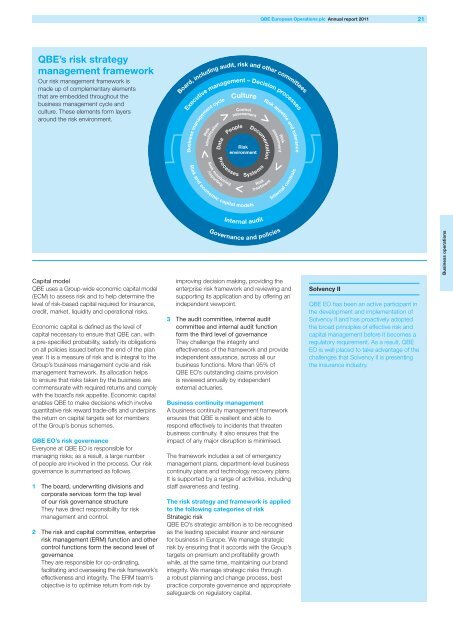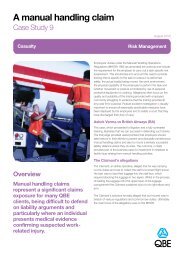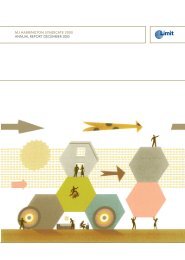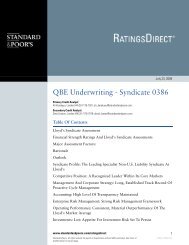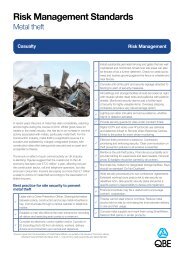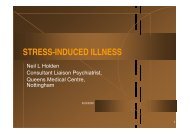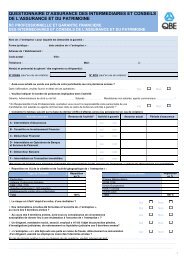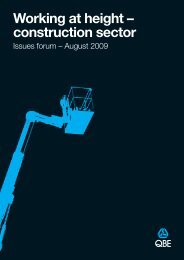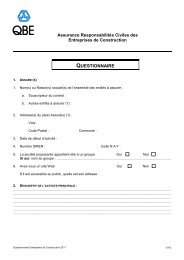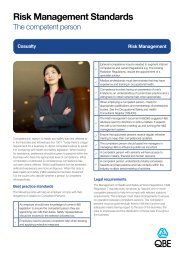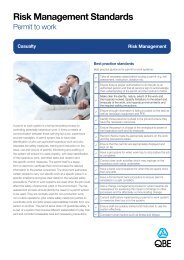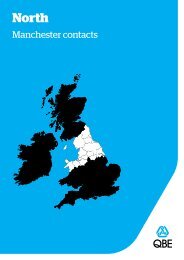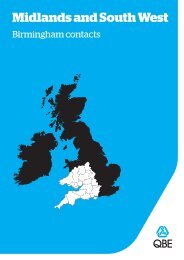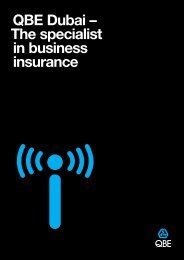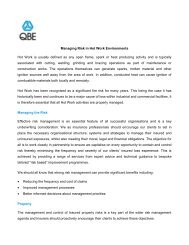QBE European Operations plc
QBE European Operations plc
QBE European Operations plc
Create successful ePaper yourself
Turn your PDF publications into a flip-book with our unique Google optimized e-Paper software.
<strong>QBE</strong> <strong>European</strong> <strong>Operations</strong> <strong>plc</strong> Annual report 2011 21<br />
<strong>QBE</strong>’s risk strategy<br />
management framework<br />
Our risk management framework is<br />
made up of complementary elements<br />
that are embedded throughout the<br />
business management cycle and<br />
culture. These elements form layers<br />
around the risk environment.<br />
Board, including audit, risk and other committees<br />
Business management cycle<br />
Culture<br />
Risk appetite and tolerance<br />
Executive management – Decision processes<br />
><br />
Risk<br />
><br />
Data<br />
identification<br />
People<br />
Control<br />
assessment<br />
Documentation<br />
Risk<br />
environment<br />
><br />
assessment<br />
Risk<br />
Processes<br />
Risk monitoring<br />
Risk and economic capital models<br />
/reporting<br />
><br />
Systems<br />
Risk<br />
treatment<br />
><br />
Internal controls<br />
Internal audit<br />
Governance and policies<br />
Business operations<br />
Capital model<br />
<strong>QBE</strong> uses a Group-wide economic capital model<br />
(ECM) to assess risk and to help determine the<br />
level of risk-based capital required for insurance,<br />
credit, market, liquidity and operational risks.<br />
Economic capital is defined as the level of<br />
capital necessary to ensure that <strong>QBE</strong> can, with<br />
a pre-specified probability, satisfy its obligations<br />
on all policies issued before the end of the plan<br />
year. It is a measure of risk and is integral to the<br />
Group’s business management cycle and risk<br />
management framework. Its allocation helps<br />
to ensure that risks taken by the business are<br />
commensurate with required returns and comply<br />
with the board’s risk appetite. Economic capital<br />
enables <strong>QBE</strong> to make decisions which involve<br />
quantitative risk reward trade-offs and underpins<br />
the return on capital targets set for members<br />
of the Group’s bonus schemes.<br />
<strong>QBE</strong> EO’s risk governance<br />
Everyone at <strong>QBE</strong> EO is responsible for<br />
managing risks; as a result, a large number<br />
of people are involved in the process. Our risk<br />
governance is summarised as follows.<br />
1 The board, underwriting divisions and<br />
corporate services form the top level<br />
of our risk governance structure<br />
They have direct responsibility for risk<br />
management and control.<br />
2 The risk and capital committee, enterprise<br />
risk management (ERM) function and other<br />
control functions form the second level of<br />
governance<br />
They are responsible for co-ordinating,<br />
facilitating and overseeing the risk framework’s<br />
effectiveness and integrity. The ERM team’s<br />
objective is to optimise return from risk by<br />
improving decision making, providing the<br />
enterprise risk framework and reviewing and<br />
supporting its application and by offering an<br />
independent viewpoint.<br />
3 The audit committee, internal audit<br />
committee and internal audit function<br />
form the third level of governance<br />
They challenge the integrity and<br />
effectiveness of the framework and provide<br />
independent assurance, across all our<br />
business functions. More than 95% of<br />
<strong>QBE</strong> EO’s outstanding claims provision<br />
is reviewed annually by independent<br />
external actuaries.<br />
Business continuity management<br />
A business continuity management framework<br />
ensures that <strong>QBE</strong> is resilient and able to<br />
respond effectively to incidents that threaten<br />
business continuity. It also ensures that the<br />
impact of any major disruption is minimised.<br />
The framework includes a set of emergency<br />
management plans, department-level business<br />
continuity plans and technology recovery plans.<br />
It is supported by a range of activities, including<br />
staff awareness and testing.<br />
The risk strategy and framework is applied<br />
to the following categories of risk<br />
Strategic risk<br />
<strong>QBE</strong> EO’s strategic ambition is to be recognised<br />
as the leading specialist insurer and reinsurer<br />
for business in Europe. We manage strategic<br />
risk by ensuring that it accords with the Group’s<br />
targets on premium and profitability growth<br />
while, at the same time, maintaining our brand<br />
integrity. We manage strategic risks through<br />
a robust planning and change process, best<br />
practice corporate governance and appropriate<br />
safeguards on regulatory capital.<br />
Solvency II<br />
<strong>QBE</strong> EO has been an active participant in<br />
the development and implementation of<br />
Solvency II and has proactively adopted<br />
the broad principles of effective risk and<br />
capital management before it becomes a<br />
regulatory requirement. As a result, <strong>QBE</strong><br />
EO is well placed to take advantage of the<br />
challenges that Solvency II is presenting<br />
the insurance industry.


